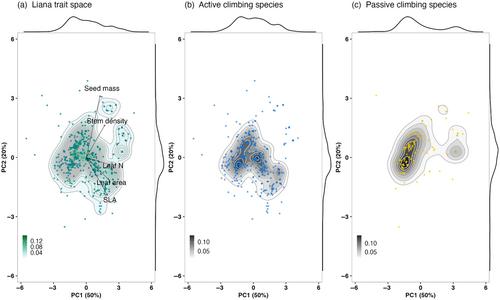Lianas are a central component of tropical forests. However, how the type of climbing mechanisms is related to the functional and taxonomic diversity of lianas across the tropics, remains largely unresolved. Here, we tested two main hypotheses: (i) the functional diversity of lianas differs with climbing mechanism (active and passive) and (ii) the association between taxonomic diversity with contemporary climate, paleoclimate, forest structure and phylogeny differ between climbing mechanisms.
Tropical forests.
Present.
Terrestrial plants.
We assembled functional traits and the type of climbing mechanism for 702 liana species and used the World Checklist of Vascular Plants (WCVP v.2.0) to standardize species names, map geographical distribution and estimate taxonomic richness. We used kernel density n-dimensional hypervolume to estimate the functional diversity of each type of climbing mechanism. We compared the environmental response of taxonomic richness of each type of climbing mechanism, active and passive, to the response of overall liana species richness. We assessed the magnitude and direction of the environmental response considering variables of climate, soil fertility and forest structure.
We found that active climbing exhibits a higher functional richness than passive climbing. Richness patterns of active and passive climbing mechanisms were mainly driven by contemporary climate, paleoclimate and phylogenetic relatedness. More importantly, paleoclimate was negatively associated with active climbing and positively associated with passive climbing.
Our study highlights differences in functional diversity (richness, dispersion, evenness and originality) between active and passive climbing species, likely reflecting their distinct ecological strategies for resource use, stress tolerance and dispersal. Integrating taxonomic and functional diversity metrics with information about the type of climbing mechanism provides deeper insights into the ecology and response of lianas to climate change.



